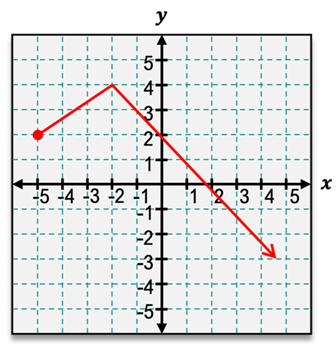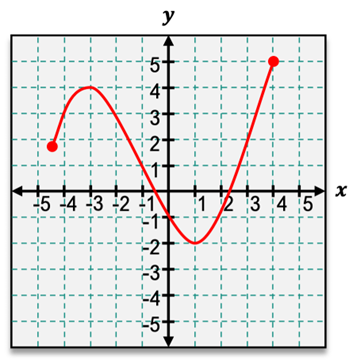In the past, we've been able to identify extrema on a graph. That's our maximum and minimum values that we know occur at the highest and lowest points of a function, but there's actually a bit more to it than that because there are 2 different types of extrema. There's global extrema, that's our highest and lowest points of our whole entire function, but also local extrema, which are going to be our highest and lowest points when considering just part of a function. Now here I'm going to walk you through the difference between these two types of extrema and also show you exactly how to identify them on a graph. So let's go ahead and get started.
Now in our example here, we are asked to determine whether each labeled point is a global max or min, a local max or min, or none of these at all. So let's start here by talking about global extrema. Now, you may also hear global extrema referred to as being absolute extrema, but just know that this means the same exact thing. Remember that earlier I said that global extrema meant we were going to consider our whole entire function. So let's get a bit more specific here.
Now we're going to be working with this x value c here. And if we plug c into our function, so we get f(c), if f(c) is then greater than or equal to f(x) for all other x values of our function, that means that this point represents a global maximum. Now on a graph, that just means that if we take a look at our whole entire function, our highest point of that whole function is our global maximum. So looking at this function specifically, I can see that my highest point is right here. So this point is my global maximum.
Now there are a couple of different ways that I could state this as an answer. I could express this as an ordered pair and say that my global maximum of my function is located at negative 35. Or I could also say that my function reaches a global maximum value of 5 at x equals negative 3. Both of these would be correct answers. Now that was our global maximum, but let's look at our global minimum.
If f(c) is instead less than or equal to f(x) for all x, that point is then a global minimum. Looking at a graph, remember, if we look at the whole entire function because we're working with global extreme values here, for a global minimum, this is going to be our lowest point of our entire function. And for this function specifically, I can see that that happens right here at negative 5, negative 5. So this point is my global minimum. So for our global extrema, we want to look at our whole entire function and identify our highest and lowest points.
Now let's shift gears to our local extrema. Now, you may also hear local extrema referred to as a relative extrema. But again, this means the same exact thing. Now for global extrema, we are looking at the whole function. For local extrema, we're now just looking at part of it.
But what exactly do I mean by that? Well, if we're looking at a local maximum, then f(c) is going to be greater than or equal to f(x) but for all nearby x. So instead of for all x like for our global maximum, this is just for all x nearby because it's just a local maximum. Now what does this look like? Well, coming over to our graph here, if I were to zoom in on this little region of my graph, I can see that this point at 24, we are higher than all of those nearby points.
So this point is a local maximum. Now what about our local minimum? Well, for our local minimum, this is going to be where f(c) is less than or equal to f(x), again, just for all nearby x values. So again, coming over here to our graph, if I zoom in on this little region here, I can see that we formed this little valley where this point 1 is. And it is lower than all of those nearby points on my graph.
So that means that this point is a local minimum. So our local extrema are just our highest and lowest points within a small region. These are typically going to look like the peaks and valleys that we see on our graph here. Now we've looked at both global and local extrema, but some points may actually be both a global value and a local value. So what does that look like?
Well, if we come back over here to our global maximum and if we zoom in just on that particular region and just look directly around it, we can see that this point, negative 35, is higher than all of those nearby points. That means that this point is not only a global maximum but also a local maximum because it's not only the highest point of our entire function, but it's also the highest point in just this particular region. Now if our global maximum is also a local maximum, what about our global minimum? Well, since our global minimum is actually the endpoint of our function here, things are going to get a bit more complicated. Now this is one of those things that in math not everyone agrees on, so we have to choose a convention to use.
Now by the convention that we're going to use here in this course, endpoints can be global extrema. Like here, this endpoint is our global minimum. But they cannot be local extrema, meaning that this endpoint cannot also then be a local minimum as well as a global because it's an endpoint. And when looking at our other endpoint here, we know that this is not a global max or min because it's not the highest or lowest value of our entire function, but it also cannot be a local max or min specifically because it's an endpoint. Now remember that this is something that can vary between your textbook or professor, so be sure to verify what convention you should use in your coursework specifically.
Now that we know what global and local extrema are and how to identify them on a graph, let's get more practice together. I'll see you in the next one.



